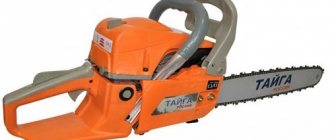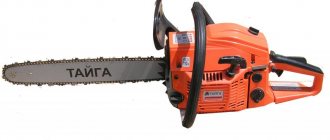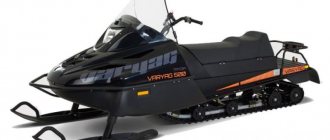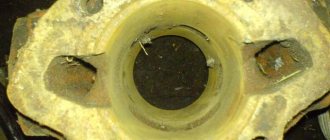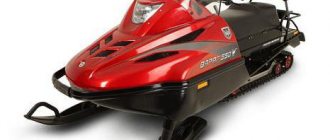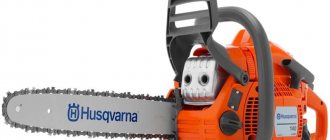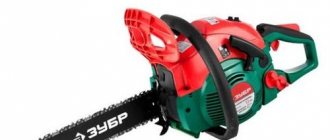Modern Taiga chainsaws will become indispensable assistants in everyday life and at work when collecting firewood or processing wood. The line of this manufacturer includes industrial, semi-professional and household models. When choosing a suitable modification, you should take into account the size of the tool, its power, performance and characteristics. Let's look at some domestic options and their closest competitors from other manufacturers.
What is the difference between the household model and the professional version?
Low-power modifications have a limited service life, low weight and size. They are designed to operate in a country house, in a garden or in the courtyard of a country house; they can work continuously for no more than an hour, but are lighter in weight and more economical.
Semi-professional Taiga chainsaws can operate up to eight hours a day. They are used to fell small trees and cut almost any wood. Industrial models are designed to work for 15-16 hours. At the same time, domestic saws are made taking into account the characteristics of a difficult and harsh climate. Compared to foreign-made analogues, this tool has a reasonable price.
The main criterion for choosing a chainsaw is the ratio of mass and power of the unit. The higher the second indicator, the more substantial the weight of the device will be, which is not so easy to work with. Therefore, you need to consider your needs and the capabilities of the tool. The category of professional saws includes devices with a power of two to six kilowatts (depending on the region of work, the hardness of the wood and the type of wood). The chain pitch for such modifications starts from 0.4 inches.
Owner reviews
Andrey, Moscow:
“Domestic manufacturers sometimes produce high-quality and indestructible chainsaws, for example, Taiga 245, manufactured in 1990, and it still works at my parents’ dacha. Two years ago I bought a TBP-6300, of course the quality is not Soviet, but it’s a good saw. We use it to prepare firewood, and haven’t had to change anything yet.”
Vladislav, Khabarovsk:
“I bought a 4500 for myself – it’s a good chainsaw. Excellent for working in suburban areas. As for the lack of bells and whistles, it works well without them, the main thing is that it doesn’t break. I've been using it for three years now. Unpretentious in fuel and oil. Pros: reliable, unpretentious. Cons: none.”
Chainsaw "Taiga Profi TBP-4000": description
This tool is a saw that runs on gasoline and has a high build quality thanks to the use of wear-resistant elements. The unit is used for all kinds of work related to felling trees, clearing clearings, forest plantations, construction, sawing and harvesting wood.
The Taiga Profi-4000 chainsaw is equipped with a productive and reliable oil pump, which guarantees the supply of appropriate lubricant to the working part of the tool (chain). This model is equipped with a Japanese Walbro carburetor, designed for uninterrupted operation at different angles, ensuring quick engine starting.
The modification in question is easy to maintain, thanks to quick access to the spark plug and air filter. The body part is made of durable plastic, and emergency chain braking is provided. Due to shock absorbers, vibration of the device is reduced. The model is equipped with an additional bar and chain.
The lineup
Initially, several versions of the chainsaw were created on the basis of the ZID, which differed:
- engine power;
- productivity;
- efficiency.
Heavier and more powerful ones were intended for industrial use. It is worth noting that the basis for all subsequent products in the line was 1 development: Taiga 214. Today the plant produces several improved models, lighter and easier to operate.
Chainsaw Taiga 214
Modern chainsaws are equipped with additional functions, such as soft start, emergency stop, continuous fuel supply, etc. Another difference is weight; chainsaws have become lighter due to the replacement of heavy metal parts with durable and lightweight plastic.
The Taiga chainsaw range includes:
- Taiga 214. First model. Intended for industrial and economic use.
- Taiga 245 (semi-professional saw for household use).
- Taiga BP-3650 (household model).
- Taiga BP-3850 (semi-professional tool).
Chainsaw Taiga BP-3850
Chainsaw Taiga TBP-4400 1
- Taiga TBP-4000.
- Taiga TBP-4400/1.
- Taiga TBP-4500.
- Taiga TBP-6300 (professional saw).
The first models 214 and 245 were developed back in the USSR and for that time they were powerful, reliable saws. Today these devices are morally outdated. It is unprofitable to use them in construction and industry. As for more modern models, they are recommended to be used for domestic needs. Some chainsaws, for example, TBP-4000, are not designed for cutting branches, as they are too heavy and cannot be used with outstretched arms.
Technical parameters of the professional model
The domestic chainsaw “Taiga Profi” has the following technical characteristics:
- power – 4 kW (5 horsepower);
- weight – 5.5 kilograms;
- gas tank capacity – 0.55 liters;
- gap between chain teeth (pitch) - 0.325 inches;
- tire length – 450 millimeters;
- start type – manual.
This combination of power, light weight, and anti-vibration protection makes it possible to use the tool when felling and sawing wood in the most difficult conditions.
For comparison, below are similar characteristics of the semi-professional modification “Taiga 52C”:
- the power indicator is 2.8 kW or 3.6 horsepower;
- weight – 5.4 kilograms;
- the tank holds half a liter of gasoline;
- The tire length is 520 millimeters.
As you can see, the industrial model has almost the same weight, but its combination with power is much higher.
Chainsaw Baikal BP-3400 – tool equipment
Among the advantages of this model, gardeners highlight increased power, an impressive reserve of torque, ease of everyday use and resistance to loads. The chainsaw is equipped with a durable 2-stroke internal combustion engine with a cylinder volume of 52 cm 3, a forged crankshaft and a piston with an increased stroke amplitude. A manual starter is responsible for the stable start of the internal combustion engine in this Baikal saw. It is supplemented with an air pump for pre-priming fuel into the working cylinder.
The manufacturer equipped the model with a highly efficient ignition system, capable of generating a spark even when starting the engine in cold weather. The branded spark plug of the petrol tool is located under a protective rubber cap. By removing it, the operator can quickly clean the part from oil stains and dried carbon deposits.
Lubrication of the saw set of the Baikal chainsaw is carried out under the control of an oil pump. Its performance can be adjusted as required by certain conditions. The chain tension on the bar is carried out using a separate screw. It is manipulated using a key.
Baikal chainsaw parameters:
- power – 4.6 l. With.;
- fuel/oil tank – 550/260 ml;
- bar length/chain pitch – 45 cm/0.325″;
- weight with headset – 6.55 kg.
The model is equipped with a durable inertial brake, which is responsible for emergency stopping of the chain. It is activated and deactivated by means of a handle located in the middle part of the body of the gas-powered tool.
Chainsaw "Taiga-245 ZID": device and brief overview
The model under consideration has long proven itself on the positive side. This reliable and powerful tool is used in the forestry sector and for household needs. Since most of the parts of the unit are made of metal, the saw has a relatively large mass (9 kg).
The device operates using a two-stroke power unit, the working volume of which is 75 cubic centimeters with a power of 2.6 kW. The motor is equipped with a built-in cylinder with a diameter of 5 centimeters. A distinctive feature of this modification is the special composition of the fuel mixture (0.5 parts of motor oil are used for 10 parts of AI-92 gasoline). The working chain is lubricated with the same oil, in warm weather - in its pure form, and in winter in a ratio of one to four with gasoline. The ZID Taiga-245 chainsaw has the following overall dimensions in length, width and height: 900x280x300 mm. The working part consists of a 400 mm bar and a chain with a pitch of 9.3 mm.
DIY repair
The Taiga 245 chainsaw does not last forever and tends to break, like any other equipment. The design of the saw is simple and allows you to repair it with your own hands, almost on your knees, using a handy tool. Let's look at the main breakdowns.
Taiga 245 manual is the main chainsaw document that you should rely on during repairs. We strongly recommend that you study not only the description, but also the content.
Dvitagel is one of the weak points of the Taiga 245 chainsaw. Common problems:
- the engine does not start;
- the engine starts, but runs unstable and/or stalls;
- works unsteadily;
- does not develop full power.
Most of the listed malfunctions occur in the saw due to problems in the ignition system. As everyone knows, the main element of the ignition system is the spark plug, therefore, the first step is to carry out a visual inspection of it.
If you can see excess fuel mixture on the spark plugs, it means it has been “flooded”; you should wipe the spark plug, dry it, put it back and try to start again.
Assess the color of the carbon deposits on the spark plugs. If it is sand-colored, then the spark plug is working. For any other color: black, yellow, red, gray, it should be replaced.
If the chainsaw spark plug is dry, then there is a problem with the fuel supply to the combustion chamber; you should check the fuel supply system.
Fuel supply system
If a malfunction is detected in the fuel supply system (dry spark plug), the first thing you should check is:
- Check the fuel filter.
- Check the flow of fuel into the combustion chamber.
Dirty filter - replace. The recommended replacement interval is once every 3 months.
To check whether fuel is flowing or not, you need to remove the hose from the carburetor and see if the fuel flows or not. If fuel comes out of the hose, then the problem lies in the carburetor. If fuel does not flow, clean the hose.
Cylinder - piston group
Problems with the CPG are classified as serious and entail high repair costs. The main causes of CPG problems are a drop in power. You can identify problems with the piston by measuring the pressure with a compression gauge in the combustion chamber. To do this, remove the spark plug, insert the device in its place and try to start the saw and look at the device readings. If the instrument needle is in the red zone (8-9 atmospheres), then piston repair is 100% necessary.
Chain brake
The chainsaw chain is stopped by a special brake band; when it becomes clogged with dirt from sawdust and oil, problems with the brake appear. The housing should be removed and thoroughly cleaned of dirt.
Over time, the muffler becomes clogged with combustion products from the spark arrester, which causes difficulty in removing exhaust gases. By creating excessive resistance in the exhaust tract, the chainsaw stops developing maximum speed. Also, the muffler becomes clogged due to excess oil in the fuel mixture.
To repair it yourself, you will need to dismantle the muffler, disassemble it and clean it thoroughly. You may have to resort to using detergents.
After dismantling the muffler, be sure to plug the exhaust hole with a rag to prevent foreign objects from getting inside the chainsaw.
Before installation, do not forget to dry the muffler with a hairdryer.
We invite you to watch a video demonstrating the operation of the ZID Taiga 245 chainsaw. A Soviet-era saw is used to cut a tree with a diameter of a meter. We recommend viewing.
Chainsaw Taiga 245 is perfect for home use. It still lacks reliability for working in the forest and is hampered by excess weight. The chainsaw is easy to repair; most faults can be fixed with your own hands. Spare parts are available and not expensive. The affordable price covers all the shortcomings and makes it an excellent mid-range saw in its class.
Carburetor structure and technical indicators of Taiga-245
Inside, the chainsaw in question is equipped with a KMP-100US membrane floatless carburetor. It has a built-in pump that supplies fuel from the gas tank to the working chamber. In addition, the pressure regulator, dampers (throttle and air), and adjusting screws interact with this element.
Taiga chainsaws go on serial sale with an already adjusted carburetor. If necessary, the settings can be adjusted using three special screws that adjust the supply of the fuel-air mixture.
"Taiga-214": a brief overview
The Taiga chainsaw, reviews of which are mostly positive, has a cantilever-type saw part, which includes a bar, chain and drive sprocket. Lubrication during operation occurs continuously in automatic mode, provided by a plunger pump. The supply unit and oil reservoir are located on the motor body. The pump is driven by a worm gear; no additional adjustment of the tool is required.
In warm weather, the same oil is used to lubricate the working part and the fuel mixture. In the cold season, it is diluted with gasoline in a ratio of one to three. The sleeve on the tire is connected to the oil tank and the guide groove through specially provided holes. Oil is supplied through the gearbox input shaft, which drives the plunger. Further, due to the rotational movements of the element, the lubricant enters the working grooves and then to the chain. The technical characteristics of model 214 are almost identical to the Taiga-245 modification.
Frequent malfunctions
One of the first Russian models of chainsaws that had a modern appearance and the ability to use the tool regardless of location in space was the Taiga 214 saw.
Let's look at the main malfunctions of Taiga chainsaws, which you can independently diagnose and fix:
- There is no spark at the spark plug contacts. Reasons: a faulty spark plug or ignition module, a broken high-voltage wire or a loose cap, the gap between the coil and the flywheel is not adjusted.
- There is a spark, but the saw does not start. Reasons: clogged fuel line or carburetor, depressurization of the crankcase, oiling of the fuel pump membrane or the main chamber of the carburetor.
- The saw starts and stalls. Reasons: strong air leaks into the crankcase, disturbances in the fuel supply system.
- The saw runs at idle, but stalls when you press the gas. Reasons: clogged main chamber injector valve, clogged fuel line, air leak into the carburetor.
- The chain rotates constantly. Reasons: clutch spring burst, increased idle speed as a result of incorrect carburetor adjustment.
- The saw spontaneously increases speed when changing its position in space. Causes: rear shock absorber is torn, carburetor is incorrectly adjusted (not enough fuel).
| Symptoms | Possible reason | Remedy |
| Chainsaw engine does not start | There is no fuel mixture in the tank. The ignition is not turned on. The spark plug is faulty or clogged. | Refuel the chainsaw Turn on the ignition Replace or repair the spark plug |
| The engine runs unevenly, after pressing the accelerator trigger it picks up speed with a delay | Carburetor adjustments are out of order | Adjust the carburetor |
| The engine starts but stalls almost immediately | Carburetor unbalanced | Restore the correct host settings |
| Work productivity has dropped sharply, the smell of burnt wood can be heard | The chain is not put on correctly The saw chain is dull | Rearrange the chain and sharpen it |
| Engine power has dropped | The muffler is faulty or dirty | Disassemble the unit, clean it of burning and accumulated debris. If necessary, replace the muffler. |
| There is a lot of smoke when the engine is running. | The dosage of oil was exceeded when preparing the fuel mixture. Instead of motor oil, chain oil was used | Drain the fuel mixture and replace it with fresh one. |
| Oil is leaking | The tightness of the oil line is broken. The oil pump is faulty. | Find the leak and restore the seal Replace the assembly |
Care and maintenance
Taiga chainsaws require regular preventative and maintenance. Its timely implementation allows you to extend the working life of the tool with proper performance.
Such activities include the following:
- Before each start-up, check the serviceability of the unit, the tightness of the fuel and oil systems, the reliability of fixation of the carburetor with the cylinder, as well as the tightening of fasteners and the tension of the operating chain.
- Cleaning the ventilation grille, air filter and carburetor deflector.
- Periodically, the filter element must be washed in gasoline or kerosene.
- At the end of the work, open and clogged components should be cleaned of chips and dirt.
- The working chain is washed in an oil-gasoline mixture, having previously cleaned it.
- Small pressed wood must be removed from the tire grooves and sprocket teeth.
- You should also clean the oil channel by unscrewing the clamping screw located at the bottom of the crankcase.
[edit] Gallery
| 1 | 3 | yes | Show | Hide |
|
Comparative parameters of the closest competitors
The Taiga chainsaw, the characteristics of which, depending on the modification, allows it to be used for domestic needs and in production, has many competitors. Let's look at the main representatives and their brief parameters.
The German model “Shtil MS-341” is a semi-professional saw, has a power of 2.6 kW, and weighs 4.5 kg. The tire has a length of three hundred and fifty millimeters. There are also many professional models from this manufacturer. Their power can reach 65 kilowatts, and the tire size is 75 centimeters.
“Husqvarna-142” - this unit from a well-known manufacturer belongs to the semi-professional category. With dimensions of 415*310*260 mm, the chainsaw has an engine capacity of 40 cubic centimeters and a power of about two and a half horsepower. It is practical and reliable.
ECHO is a gasoline saw from a young but actively developing Japanese company that has taken its rightful place in the world market. For example, the CS-305WS 14 model, with a power of two horsepower, easily fells small trees, is easy to use, and economical.
Caliber BP 2200 18U
This saw has serious power, which semi-professional and professional models can boast of.
Power 3 hp or 2.2 kW is enough to cut with an 18-inch tire along its entire length. It is difficult to saw hard wood, for example, maple or birch, but this saw can handle pine, willow (white willow) and other soft types of trees without difficulty, even when working the entire length of the saw set.
Externally, the PSU 2200/18u can only be distinguished from its predecessors by the length of the bus. An experienced specialist will find the difference by looking at the piston, because she's a little bigger.
The saw Caliber BP 2200/18 is heavier than previous models, only 100 grams, resulting in a weight of 6.2 kg. Of course, this is not critical, because... its specific power is significantly higher and amounts to 2.06 hp/kg.
What do the owners say?
The Taiga chainsaw, reviews of which can be found on special forums and trading resources, is in great demand among the population. Particularly popular are the latest models, which combine high performance, durability and low weight. There are no particular complaints about the functionality of this tool. Owners make certain complaints about the carburetor, which often gets clogged and takes a lot of time to clean. In some models, users are not satisfied with the air filters, which they advise immediately replacing with a more practical option.
About this element we can say that it is nylon or made of fabric (felt). The first option is easy to clean, suitable for reusable use, however, it is damaged if large sawdust gets in. The felt filter is more resistant to mechanical stress, but is quite difficult to clean.
Manufacturer country
This article has nothing to do with Taiga ZiD chainsaws, since there is no information on the official ZiD website that the plant is currently producing chainsaws. If you are interested in information on Soviet-made Taiga chainsaws, then read our review articles: Taiga 214, Taiga 245.
Then where are the saws produced that are sold today under the name Taiga? We can definitely say that they are made in China, but who imports them into our country is unknown. These chainsaws do not have an official website, service centers, in general, there is no reliable information about who should be responsible for quality.
Their Chinese origin can be determined by their appearance, body and engine details. Many people probably know the “Gypsy” chainsaw, but here are the Taiga saws, one of its varieties, only with a different color.
Let us immediately make a reservation that this information is not official, conclusions are drawn based on comparison.
Bottom line
It can be noted that the Taiga TBP-4000 chainsaw is a reliable assistant in the professional field, it has significant power with low weight. The introduction of innovative materials made it possible to make it competitive not only with domestic, but also with foreign analogues.
Other modifications from this manufacturer are also quite successfully used in everyday life, private enterprise, public utilities and industry. Some of Taiga's competitors were noted above. Among the domestic units we can mention chainsaws: “Druzhba”, “Energomash”, “Ural”, “Zubr”. Knowing the basic selection criteria and technical features of the device, you can easily choose a device that suits your needs and the fullness of your wallet.
No "friendship"!
There is an opinion that the first domestic chainsaw appeared in the 50s, and it was the legendary “Friendship”, around the birth of which a huge number of fables have been piled up. In fact, domestic chainsaws appeared two decades before “Friendship” and managed not only to fight in the Finnish and Great Patriotic Wars, but even... to receive an Oscar.
Wehrmacht chainsaws
During the war, several manufacturers of motor saws were located in Germany itself and in the territories under its control, so the Germans had no problems with the choice. The most famous, perhaps, are two models - the Dolmar CL and the Stihl KS43, which was a more powerful version of the Stihl BDKH and Stihl BDK models of the mid-1930s.
Dolmar CL chainsaw, model 1939. Engine capacity 241 cm3, power 8 hp, weight 45 kg. The Stihl KS43 chainsaw of the 1943 model was similar in power, but due to the use of light alloys it turned out to be much lighter: engine capacity 247 cm3, power 8.5 hp, weight 36 kg
The Dolmar CL model chainsaw could be seen in the old exhibition of the Minsk Museum of the Great Patriotic War, in the exhibition with a partisan camp
Of course, these are not the only models of chainsaws available to the German army during the Second World War, but they are usually referred to in cases where they want to compare “theirs and ours.” “In our country,” as a rule, they show hand saws and draw conclusions about the disparate technical equipment of the armies of Germany and the USSR. But are these conclusions true?
Chainsaws of the Red Army
Due to the peculiarities of the Soviet economy, one cannot expect a large number of Soviet brands of chainsaws (at that time they said not “model”, but “brand”). In fact, the USSR met 1941 with one MP-220 chainsaw. The MP-300 saw, developed in the early 30s, is already outdated, and the new MP-180 appeared later.
Chainsaw MP-220, model 1935 (an improved model MP-220A was produced in 1941). Engine capacity 220 cm3 (effective 187 cm3), power 3.5 hp, weight 32 kg
At different times, this model was produced by a motorcycle plant in Izhevsk and the Perm Machine-Building Plant, now named after Dzerzhinsky - as we see, ZiD began producing chainsaws 20 years before the appearance of “Druzhba”!
Unfortunately, wartime sources do not spoil us with specific models of Soviet chainsaws. In textbooks and standards of military engineers, reports, statistics and even factory archives, they most often wrote simply “motor saw” or “chain saw” - no brand, no power, no weight. But there are two numbers that can be used reliably:
Still from the documentary “The Defeat of German Troops near Moscow”
“Note from the NGOs of the USSR and the General Staff of the Red Army to the Politburo of the Central Committee of the All-Union Communist Party (Bolsheviks) I.V. Stalin and the Council of People's Commissars of the USSR V.M. Molotov outlining the scheme for the mobilization deployment of the Red Army” reports that on January 1, 1941, the Red Army had 3,908 motor saws. And in the book “Engineering Troops of the Soviet Army 1918-1945” in the table “production of engineering weapons during the Great Patriotic War” there is a line “motor saws” indicating their number - 3598 pieces.
In total, we have approximately 7,500 motor saws of our own production, which passed through the army during the war. There may be some questions about this number, but it gives the general picture - the number of domestically produced motor saws was measured in thousands of pieces.
The Oscar-winning chainsaw
So, what are we talking about? We are talking about the 1942 Soviet film “The Defeat of German Troops near Moscow” and its American version “Moscow Strikes Back”, which received an Oscar in the 1943 category “Best Documentary Film”. At the beginning of the film (in the Soviet version at the end of the 10th minute) there is a scene of creating a forest blockage using a chain saw.
Documentary film “The defeat of German troops near Moscow.” Required episode from 09:59 timing
Based on the characteristic all-rotating design, the direction of the exhaust, the shape of the tank and the impeller casing, it can be clearly established that this is an MP-220 chain saw. There is unexpected evidence that during the Great Patriotic War, domestic chainsaws not only existed, but also “received” the Oscar film award - although not individually, but as part of a team.
